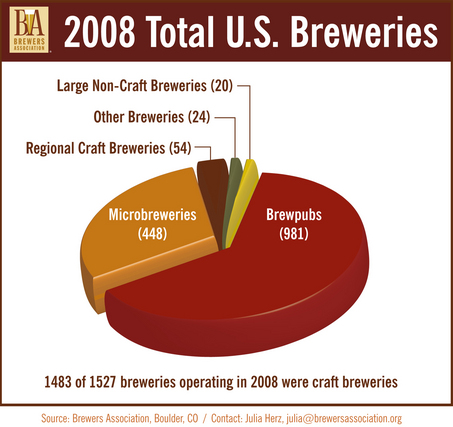 March 11th, 2009
brewers association . brewers association 2008 report . National Brewers Association
March 11th, 2009
brewers association . brewers association 2008 report . National Brewers Association
Craft Beer sales increased in 2008
In February, the Brewers Association released their 2008 reports. It was tough time for industry, facing challenges from many fronts (rising cost of grains, increased shipping costs and recipe modifications due to the hop shortage) . To face these challenges, many breweries reached out and helped each other. This act of kindness proved to be invaluable and resulted in a healthy increase for the total volume of sales.
With total U.S. beer being more than a $100 billion industry, the Brewers Association estimates the actual dollar sales from craft brewers in 2008 were $6.34 billion, up from $5.74 billion in 2007. Taxable barrels of the total beer alcohol category was 1,210,018 more in 2008 with craft brewers producing 473,364 of those barrels. Total craft brewer barrels for 2008 was 8,596,971, up from 8,123,607 barrels in 2007.
Despite the difficulties, the total number of breweries also increased in 2008.
The total number of U.S. breweries also increased from 1,463 to 1,527 with 63 new microbreweries being added, including two in Michigan — Liberty Street Brewing Company in Plymouth and Original Gravity Brewing Co. in Milan.

It hasn’t been easy to get there..
These increases in share and barrels for craft brewers come at a time when, according to the Brewers Association, the cost of operating a small brewery increased over 39 percent from November 2007 to November 2008. The Brewers Association states that today’s craft brewers face many challenges including:
· Access to ingredients and raw materials
· Increased pricing for materials and supplies
· Access to market (competition for shelf space at the retail level)
Who is the considered to be a craft brewer?
An American craft brewer is small, independent, and traditional. Small: Annual production of beer less than 2 million barrels. Beer production is attributed to a brewer according to the rules of alternating proprietorships. Flavored malt beverages are not considered beer for purposes of this definition. Independent: Less than 25% of the craft brewery is owned or controlled (or equivalent economic interest) by an alcoholic beverage industry member who is not themselves a craft brewer. Traditional: A brewer who has either an all malt flagship (the beer which represents the greatest volume among that brewers brands) or has at least 50% of its volume in either all malt beers or in beers which use adjuncts to enhance rather than lighten flavor.
It wouldn’t be wrong to say that we’ve all helped craft beer increase, because we have. Whether we are visiting our local brewery or we are sharing stories of a great new beer that we found, we are doing our part. We are making a similar choice. We want something that is different. We want something that creates a party with our taste buds. We want good beer.
The best part is that breweries are stepping up to this challenge. They are creating beers that never existed. They are being creative in their craft.  Soon, the rest of the world will recognize what’s happening here and follow in our footsteps.
Sean
Drink Craft Beer, You’ve Earned It!!
Additional information about the Brewers Association reports can be found here:
2008 numbers are up for nation’s small craft brewers.
Brewers Association Announces 2008 Craft Brewer Sales Numbers.